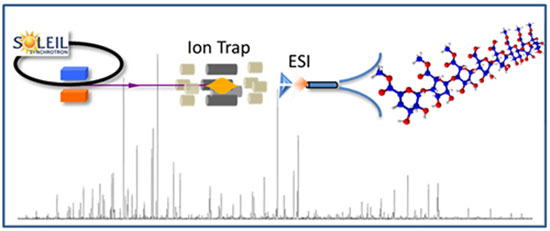A research team from INRA Nantes used an innovative method based on mass spectroscopy using synchrotron radiation of DISCO beamline to photoactivate sugars, whose valorisation presents a real economic interest for several industries (food-processing industry, pharmaceuticals, cosmetics).
The knowledge of the structure in biological molecules is crucial for either understanding their role or mastering their potential use. “Sugars”, in particular, or carbohydrates, are naturally abundant molecules, whose valorisation presents a real economic interest for several industries (food-processing industry, pharmaceuticals, cosmetics). The complexity and heterogeneity of such structures pose a real challenge to analytical sciences. A research team from INRA Nantes used an innovative method based on mass spectroscopy using synchrotron radiation of DISCO beamline to photoactivate molecules. Their study put the light on this set-up to characterize the structure of carbohydrates, allowing even the identification of subtle chemical changes carried out by these molecules. Their current work aims at the generalization of the conclusions obtained for a better understanding of the occurring phenomena. Eventually the idea would be to make results reachable with more conventional analytical devices.

Scheme of the experimental plan used on DISCO beamline at SOLEIL. It gives access to photoactivation of carbohydrates put by Electrospray (ESI) in the ion trap of the mass spectroscope. Photoactivation is realized with highly energetic photons and produces a lot of fragments, which informative content is better to those obtained with conventional activation methods.
Sensitive, fast and with a remarkable informative contain, mass spectroscopy appears to be the method to choose to address structural determination of biological molecules. The characterization of molecules structure with mass spectroscopy consists in “breaking” the molecules and measuring the weight of obtained fragments in order to rebuild it like a puzzle. Although it is powerful in many cases, the conventional method used (LE CAD), available in many laboratories, fails in determining complex carbohydrates structures because the piece of information obtained to rebuild the puzzle become insufficient.
In that context, scientists have assessed a new fragmentation method based on the activation of molecules with high energy photons. Such a device is available on DISCO beamline at synchrotron SOLEIL, with the advantage of giving access to highly energetic photons in a wide range (from 5 to 22eV). Original even in the small world of synchrotrons, this fitting was used here for the first time to compare fine structure of complex carbohydrates. The concerned carbohydrates were expected to produce much more informative fragments, by following different fragmentation ways from the one observed with LE CAD, and leading to a non-ambiguous and more complete structural characterization.
A complex mixture of carbohydrates coming from the enzymatic degradation of citrus pectin was chosen to assess the method. Pectins are massively used in food industry due to their gelling property, and this ability is known to be highly dependent on subtle chemical changes (methyl groups) carried by galacturonic acids that build up their skeleton.
Under activation with synchrotron radiation, carbohydrates gave more fragments, and even more informative than the ones produced with a conventional method. In addition, fragmentation rules have been settled irrespective of the chemical groups of molecules. This allowed to systematize the interpretation of the spectra, and to reach an easier and more complete interpretation.
The contribution of the work is technologic- demonstrating that photoactivation at high energy leads to complementary and more informative fragments compared to LE CAD ones. Moreover, this study is by far the most exhaustive and precise in terms of resolved structures on degraded products of pectins, with almost 40 structures fully characterized including the chemical changes happening inside. All this gave new information on the enzyme action mode.
Works in progress now aim at expanding our observations to other carbohydrates classes, to establish the genericity of the observed phenomena. The originality lies in the structural resolution of complex carbohydrates. This work already raises the interest of scientists, especially those working on molecules functions and properties.
